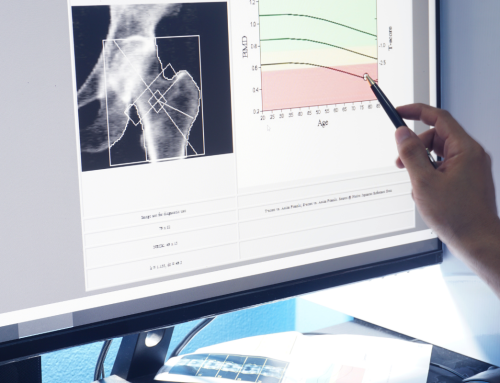
Between osteolysis, osteopenia, and osteoporosis, bone loss is the common denominator for these three conditions and diseases. Fractures are the #1 cause of death and disability in our elderly population. It’s crucial to pay attention to your lifestyle, diet, and overall health so that you can make proactive changes before you encounter one of these conditions. While all are known as silent diseases or conditions, osteolysis comes from a different cause, requires different treatment, and can present other symptoms as it progresses. Read on to learn more about osteolysis and how it differs from osteopenia (the less severe diagnosis before osteoporosis).
What is Osteolysis Bone Loss
When you think of bone loss, you may categorize it as one umbrella of conditions. However, that is not the case when it comes to osteolysis.
Diseases such as osteopenia and osteoporosis affect your entire body and are the generalized process of bone loss that can lead to weakened bones and a higher risk of fractures. Osteolysis is one targeted area that is destroying a part of the bone. Typically, this area can heal with treatment, but a large enough area of osteolysis can weaken that bone or even cause a fracture.
Another differentiating factor is the cause behind the condition or disease. For osteoporosis and osteopenia patients, there is a long list of possibilities that could lead them to this disease. From diet to genetics and sedentary lifestyles, there is not always a clear suspect for what brought it on. Osteolysis, on the other hand, occurs when cells in the bone (known as osteoclasts) increase their activity and break down the surrounding materials. Osteolysis is typically from one of 3 major causes:
- Cysts or cancers that are growing on the bone that cause bone loss or abnormal bone growth.
- Joint prosthetics (the material used if you need a joint replacement) can cause a disruption in your body. They can prevent your body from making new bone and may even attack the bone cells because of the foreign particles it comes into contact with.
- Conditions that lead to bone loss, such as arthritis, periodontal disease, etc.
Types of Osteolysis
Unlike osteopenia or osteoporosis, which affect your whole body and are generalized diseases, osteolysis can target an area of bone. There are three common types that you may have heard of or even experienced yourself.
Distal clavicular osteolysis
Distal clavicular osteolysis is a fancy term for this condition affecting your shoulder. The distal clavicle is commonly called your AC joint. Just like the tennis elbow, this condition got its own name - “weight lifter’s shoulder.”
The AC joint, where a part of the shoulder blade meets the collar bone, allows you to raise your arms above your head easily. However, in some people, the end of the collarbone at the AC joint can lose calcium, soften, and even erode.
There is no “one cause fits the condition,” but there are several factors that could point to why this occurs:
- Numerous injuries to the AC joint or collarbone.
- Repetitive motions with heavy weights (where it got the nickname ‘weightlifters shoulder’ from)
- Underlying diseases or conditions, such as arthritis, etc., can be worse when combined with long-term wear of the shoulder.
What can start as a dull ache or tenderness of the area can turn into a sharp pain during activity. Distal clavicular osteolysis has straightforward treatment to reduce pain and minimizes movement while allowing the bone to rebuild.
- Icing the area.
- Lots of rest.
- Anti-inflammatory medication.
- If remineralization doesn't occur, surgery may be an option.
Periprosthetic Osteolysis
Another type of osteolysis occurs due to a complication from joint replacement surgery. While most patients recover with no problems popping up, occasionally, polyethylene or other materials in the implant can wear down. When this happens, debris can be found surrounding the joint tissue and cause inflammation that causes the degeneration of the bone.
There are often no symptoms until there has been extensive bone loss, which is why attending follow-up X-ray appointments after joint replacement is crucial. If symptoms surface, they include pain, weakness, and stiffness in the area.
If caught early, several treatments can be used to prevent further osteolysis. If there is a lot of bone loss, a joint replacement revision surgery may be needed.
Acro-osteolysis
Acro-osteolysis occurs when the bone in the fingers or toes erodes and degenerates. This is usually caused by an underlying inflammatory condition such as genetic disorders, infections, or issues such as arthritis, scleroderma, etc.
This can be more common in people who use vibratory power tools extensively, have been exposed to vinyl chloride, or have elevated parathyroid hormone levels. Treatment for this type of osteolysis correlates with treating the underlying condition.
The Difference Between Osteolysis and Osteopenia
While the bone loss may be the common factor between osteolysis and osteopenia, their causes, treatments, and how they may affect your lifestyle differ. The best thing you can do for your bones is to give them a nutrient-dense diet packed full of calcium and exercise regularly to promote blood flow. Just remember to weave in stretching and restorative movements between any strengthening activity.
Are you experiencing bone loss or at risk? Without adding another significant lifestyle change, you can begin to experience building better bones at home. Using a NASA-inspired LiV device, you’ll naturally stimulate your body in only 10 minutes per day. Contact us to find out how it can help you live a longer, healthier, more independent life.
Have you heard of osteolysis before this article? What surprised you about the condition? Share your experience with our readers that are learning more about bone loss diseases and conditions.




 Black Friday → Christmas Sale! Save $300 + Free Shipping
Black Friday → Christmas Sale! Save $300 + Free Shipping 